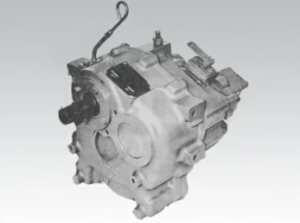
Introduction
- Overview of the Twin Disc MG502 Marine Gear
- Importance of Regular Maintenance
- Safety Precautions
1. Understanding the Twin Disc MG502 Marine Gear
- Basic Components and Their Functions
- Operational Principles
- Common Applications
2. Pre-Service Checklist
- Required Tools and Equipment
- Safety Gear and Precautions
- Inspection Steps Before Service
- Maintenance Schedule Overview
3. Disassembly Instructions
- Preparation for Disassembly
- Step-by-Step Disassembly Process
- Identifying Wear and Tear Components
- Handling and Storing Components
4. Inspection and Diagnostics
- Visual Inspection Techniques
- Identifying Common Faults (e.g., Leaks, Cracks, Wear)
- Diagnostic Procedures for Malfunctions
- Measuring Tolerances and Clearances
5. Cleaning and Maintenance Procedures
- Cleaning Guidelines for Major Components
- Lubrication Requirements
- Seal and Gasket Replacement
- Best Practices for Preventing Corrosion
6. Reassembly Instructions
- Pre-Assembly Checklist
- Step-by-Step Reassembly Guide
- Torque Specifications for Fasteners
- Testing Component Alignment
7. Final Testing and Operational Checks
- Initial Testing Procedures
- Load Testing and Calibration
- Noise and Vibration Checks
- Post-Service Inspection Checklist
8. Troubleshooting Common Issues
- Difficulty Engaging Gear
- Excessive Noise or Vibration
- Fluid Leaks and Seal Failures
- Overheating Concerns
- Control System Malfunctions
9. Maintenance Schedule
- Daily, Weekly, and Monthly Maintenance Tasks
- Seasonal Checks for Marine Environments
- Component Life Expectancy and Replacement Guidelines
10. Recommended Spare Parts and Tools
- Essential Spare Parts List
- Recommended Tools for Onboard Repairs
- Tips for Efficient Parts Replacement
11. Safety and Compliance Considerations
- Environmental Regulations for Marine Equipment
- Waste Disposal and Recycling of Old Parts
- Best Practices for Safe Operation
12. Storage and Preservation Tips
- Long-Term Storage Preparations
- Preventive Measures Against Environmental Damage
- Periodic Checks During Storage
Frequently Asked Questions (FAQ) About The Twin Disc MG502 (Marine Gear)
Disclaimer: For more technical and detailed instructions, refer to the OEM service manual provided by Twin Disc Incorporated. This guide is intended for general maintenance assistance and does not replace official service protocols.
Videos About Twin Disc Transmissions
6 Reasons Your Twin Disc Transmission Has Low Oil Pressure
6 Causes of Low Oil Pressure in Twin Disc Transmissions:
- Partially Clogged Oil Strainer Debris or sediment in the oil system can restrict flow at the strainer, starving the pump and causing pressure to drop.
- Stuck Pressure Regulation Piston in Selector Valve Assembly If the pressure-regulating piston is stuck or gummed up, it can prevent proper oil pressure regulation within the valve body.
- Broken Piston Rings on Clutches These rings help seal hydraulic pressure inside clutch packs. Cracked or broken rings allow oil to bypass, reducing line pressure and engagement strength.
- Damaged or Worn Oil Pump Assembly A failing or inefficient oil pump won’t deliver the flow and pressure required for normal clutch operation and cooling.
- Incorrect Linkage Installed on Selector Valve Assembly Improper linkage geometry or incorrect adjustment can cause the valve to misalign, preventing full hydraulic engagement or signal.
- Clogged or Plugged Orifice in Orifice Plate of Selector Valve Assembly A blocked orifice restricts pressure build-up in key circuits, leading to uneven or delayed pressure response in clutch packs.
7 Reasons Your Twin Disc Transmission Is Overheating
1) Insufficient Heat Exchanger Capacity If your transmission cooler or heat exchanger is undersized for the application, it won’t shed enough heat, especially under load or in hot climates.
2) Insufficient Cooling Water Flow Blockages, pump failures, or restricted raw water flow can drastically reduce cooling efficiency and cause transmission fluid temperatures to rise.
3) Clutches Slipping Worn or improperly adjusted clutches create internal friction, resulting in heat buildup that the cooler system may not overcome.
4) Oil Levels Too High Overfilled transmission cases can cause oil to aerate, reducing lubrication and increasing heat due to frothing.
5) Improper Oil Sump Using a sump that doesn’t match the transmission’s flow and capacity specs can lead to recirculation problems and overheating.
6) Trolling at Too High Engine Speed Running the engine too fast while trolling (especially in gear) can overload the transmission clutches, increasing heat without enough cooling time.
7) Warped Clutch Plates Heat-warped or damaged clutch plates drag inside the transmission and reduce internal clearance, causing continuous friction and heat buildup.
3 Reasons Your Clutch Plates in Your Twin Disc Transmission Are Making Excessive Noise
1. Worn or Glazed Clutch Plates Over time, clutch plates can experience wear or become glazed due to high operating temperatures and friction. This condition reduces the friction coefficient between the plates, leading to slippage and the generation of unusual noises during engagement. Regular inspection and timely replacement of worn or glazed clutch plates are essential to ensure smooth operation.
2. Insufficient or Contaminated Hydraulic Oil Hydraulic oil plays a pivotal role in the engagement and disengagement of clutch plates. Low oil levels or contamination with debris can impede proper clutch function, resulting in noise and potential damage. It’s imperative to maintain appropriate oil levels and ensure the hydraulic fluid is clean and meets the manufacturer’s specifications. Diesel Pro
3. Misalignment or Improper Installation Incorrect installation or misalignment of clutch components can cause uneven contact between plates, leading to excessive noise during operation. Ensuring that all components are correctly aligned and torqued to the manufacturer’s specifications during installation is vital to prevent such issues.
Bull Gear On A Twin Disc Transmission
Rebuilt Twin Disc Transmissions
Buy A Rebuilt Twin Disc Transmission



 Free US Calls: 1-888-433-4735
Free US Calls: 1-888-433-4735 International: 305-545-5588
International: 305-545-5588